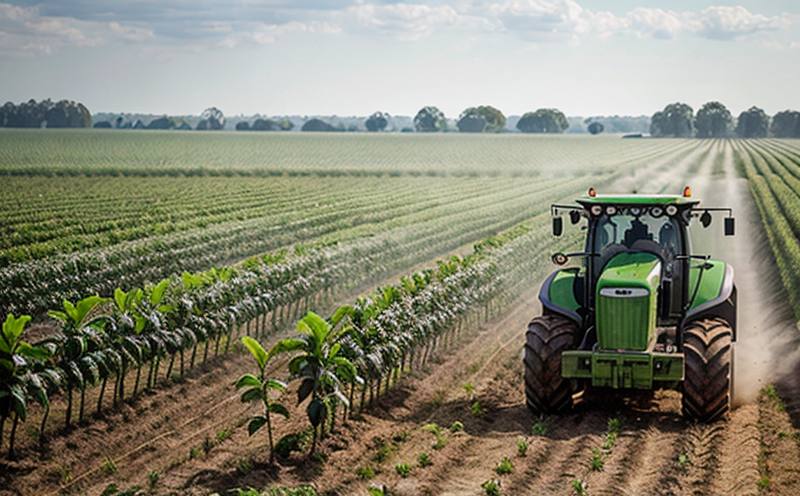USP 467 Residual Solvent Testing in Agricultural Substances
The United States Pharmacopeia (USP) Chapter 467, titled "Residual Solvents," provides a standardized method for the detection and quantification of residual solvents in various substances, including agricultural products. This service ensures that agricultural chemicals used in growing crops do not leave behind harmful residues on harvested produce, thereby ensuring food safety.
The significance of this testing cannot be overstated in today’s stringent regulatory environment. Agricultural chemicals are often used to enhance plant growth and protect crops from pests and diseases; however, the use of certain solvents during processing can lead to contamination if not properly managed. USP 467 provides a robust framework for identifying these solvents and ensuring they fall within acceptable limits.
The testing process involves several critical steps that are detailed in the chapter itself. Initially, samples must be prepared according to specific guidelines to ensure accuracy. This includes washing, drying, and optionally extracting the sample with an appropriate solvent. Once prepared, the sample is subjected to a gas chromatography (GC) analysis using a flame ionization detector (FID). The GC-FID system allows for precise identification and quantification of residual solvents.
The service offered here ensures that all samples are tested according to USP 467 guidelines. Our team uses state-of-the-art equipment, including a Shimadzu GC-2014 Plus coupled with FID detection. This setup guarantees high sensitivity and selectivity in detecting even trace amounts of residual solvents.
The results from this testing are crucial for quality managers and compliance officers within agricultural operations. By adhering to USP 467, organizations can ensure that their products meet the highest safety standards set by regulatory bodies like the FDA or USDA.
Understanding the importance of this service extends beyond just ensuring food safety; it also plays a role in maintaining consumer trust and protecting brand reputation. Consumers increasingly demand transparency regarding how their food is produced, and compliance with USP 467 demonstrates commitment to these values.
The methodology prescribed by USP 467 has been widely accepted not only within the United States but internationally as well. This widespread acceptance underscores its reliability and relevance in global markets.
| Applied Standards | Description |
|---|---|
| USP Chapter 467 | Details the procedure for testing residual solvents in agricultural substances. |
| ASTM E932-18 | Sets specifications and performance requirements for GC-FID systems used in this testing. |
The applied standards ensure that the tests conducted are consistent with internationally recognized practices. This consistency is vital when dealing with global supply chains where products may be consumed across multiple jurisdictions.
The methodology employed in USP 467 testing involves several key steps, each of which contributes to accurate and reliable results:
- Sample Preparation: Samples are prepared according to specific guidelines provided by the chapter. This includes washing, drying, and optionally extracting with a solvent.
- Extraction: The sample is extracted using a suitable solvent, ensuring thorough removal of any potential residual solvents.
- Analysis: The extracted solution undergoes gas chromatography (GC) analysis coupled with flame ionization detection (FID). This allows for precise identification and quantification of the solvents present.
The use of GC-FID ensures that even trace amounts of residual solvents are detected, making this method highly sensitive. The results from this analysis provide a clear picture of the levels of residual solvents in agricultural substances.
Understanding the importance and methodology behind USP 467 testing is crucial for those involved in agricultural operations. Whether you're an R&D engineer looking to optimize production processes or a compliance officer ensuring regulatory adherence, this service offers invaluable insights into maintaining product safety and quality.
Applied Standards
| Standard | Description |
|---|---|
| USP Chapter 467 | This chapter provides the specific methodology for testing residual solvents in agricultural substances. |
| ASTM E932-18 | Sets out the performance requirements and specifications for gas chromatography-flame ionization detection (GC-FID) systems used in this testing. |
The standards applied in USP 467 are designed to ensure consistent, accurate results across different laboratories. The use of internationally recognized standards such as those from ASTM adds credibility to the test results and facilitates easier acceptance by regulatory bodies worldwide.
Scope and Methodology
| Methodology Detail | Description |
|---|---|
| Sample Preparation: | The sample is washed, dried, and optionally extracted using a suitable solvent. |
| Extraction: | The sample undergoes extraction with an appropriate solvent to ensure thorough removal of potential residual solvents. |
| Analysis: | The extracted solution is subjected to gas chromatography (GC) analysis coupled with flame ionization detection (FID). |
The methodology outlined in USP 467 ensures that the testing process is both comprehensive and precise. The use of GC-FID allows for accurate identification and quantification of residual solvents, even at trace levels.
Frequently Asked Questions
International Acceptance and Recognition
- Regulatory Bodies: USP 467 is widely accepted by regulatory bodies such as the FDA, USDA, and others.
- Global Markets: The method's reliability ensures its acceptance in international markets where food safety is a priority.
- Industry Standards: It serves as an industry standard for ensuring compliance with international standards of agricultural chemical usage.
The widespread acceptance of USP 467 by these entities highlights its importance and reliability. The method's robustness in detecting residual solvents makes it a cornerstone of global food safety practices.





